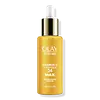What's inside
What's inside
 Key Ingredients
Key Ingredients

 Benefits
Benefits

 Concerns
Concerns

 Ingredients Side-by-side
Ingredients Side-by-side

Water
Skin ConditioningGlycerin
HumectantDimethicone
EmollientNiacinamide
SmoothingLactic Acid
BufferingPolyacrylate Crosspolymer-6
Emulsion Stabilising3-O-Ethyl Ascorbic Acid
Skin ConditioningPalmitoyl Pentapeptide-4
Skin ConditioningPalmitoyl Dipeptide-7
Skin ConditioningPanthenol
Skin ConditioningTrehalose
HumectantPEG-11 Methyl Ether Dimethicone
EmulsifyingSodium Lactate
BufferingSodium Benzoate
MaskingParfum
MaskingWater
Skin ConditioningAscorbic Acid
AntioxidantDimethicone
EmollientGlycerin
HumectantAlcohol Denat.
AntimicrobialPotassium Hydroxide
BufferingPolysilicone-11
Pentaerythrityl Tetraethylhexanoate
EmollientAcetyl Dipeptide-1 Cetyl Ester
Skin ConditioningAdenosine
Skin ConditioningSodium Hyaluronate
HumectantTocopherol
AntioxidantSilica
AbrasiveAmmonium Polyacryloyldimethyl Taurate
Emulsion StabilisingButylene Glycol
HumectantCaprylyl Glycol
EmollientC13-14 Isoparaffin
EmollientHydroxyethylcellulose
Emulsion StabilisingLaureth-7
EmulsifyingPEG-20 Methyl Glucose Sesquistearate
EmulsifyingPoloxamer 338
EmulsifyingPolyacrylamide
Sorbitan Laurate
EmulsifyingXanthan Gum
EmulsifyingBis-PEG/PPG-16/16 PEG/PPG-16/16 Dimethicone
EmollientCaprylic/Capric Triglyceride
MaskingPentaerythrityl Tetra-Di-T-Butyl Hydroxyhydrocinnamate
AntioxidantSalicylic Acid
MaskingParfum
MaskingWater, Ascorbic Acid, Dimethicone, Glycerin, Alcohol Denat., Potassium Hydroxide, Polysilicone-11, Pentaerythrityl Tetraethylhexanoate, Acetyl Dipeptide-1 Cetyl Ester, Adenosine, Sodium Hyaluronate, Tocopherol, Silica, Ammonium Polyacryloyldimethyl Taurate, Butylene Glycol, Caprylyl Glycol, C13-14 Isoparaffin, Hydroxyethylcellulose, Laureth-7, PEG-20 Methyl Glucose Sesquistearate, Poloxamer 338, Polyacrylamide, Sorbitan Laurate, Xanthan Gum, Bis-PEG/PPG-16/16 PEG/PPG-16/16 Dimethicone, Caprylic/Capric Triglyceride, Pentaerythrityl Tetra-Di-T-Butyl Hydroxyhydrocinnamate, Salicylic Acid, Parfum
 Reviews
Reviews

Ingredients Explained
These ingredients are found in both products.
Ingredients higher up in an ingredient list are typically present in a larger amount.
Dimethicone is a type of synthetic silicone created from natural materials such as quartz.
What it does:
Dimethicone comes in different viscosities:
Depending on the viscosity, dimethicone has different properties.
Ingredients lists don't always show which type is used, so we recommend reaching out to the brand if you have questions about the viscosity.
This ingredient is unlikely to cause irritation because it does not get absorbed into skin. However, people with silicone allergies should be careful about using this ingredient.
Note: Dimethicone may contribute to pilling. This is because it is not oil or water soluble, so pilling may occur when layered with products. When mixed with heavy oils in a formula, the outcome is also quite greasy.
Learn more about DimethiconeGlycerin is already naturally found in your skin. It helps moisturize and protect your skin.
A study from 2016 found glycerin to be more effective as a humectant than AHAs and hyaluronic acid.
As a humectant, it helps the skin stay hydrated by pulling moisture to your skin. The low molecular weight of glycerin allows it to pull moisture into the deeper layers of your skin.
Hydrated skin improves your skin barrier; Your skin barrier helps protect against irritants and bacteria.
Glycerin has also been found to have antimicrobial and antiviral properties. Due to these properties, glycerin is often used in wound and burn treatments.
In cosmetics, glycerin is usually derived from plants such as soybean or palm. However, it can also be sourced from animals, such as tallow or animal fat.
This ingredient is organic, colorless, odorless, and non-toxic.
Glycerin is the name for this ingredient in American English. British English uses Glycerol/Glycerine.
Learn more about GlycerinParfum is a catch-all term for an ingredient or more that is used to give a scent to products.
Also called "fragrance", this ingredient can be a blend of hundreds of chemicals or plant oils. This means every product with "fragrance" or "parfum" in the ingredients list is a different mixture.
For instance, Habanolide is a proprietary trade name for a specific aroma chemical. When used as a fragrance ingredient in cosmetics, most aroma chemicals fall under the broad labeling category of “FRAGRANCE” or “PARFUM” according to EU and US regulations.
The term 'parfum' or 'fragrance' is not regulated in many countries. In many cases, it is up to the brand to define this term.
For instance, many brands choose to label themselves as "fragrance-free" because they are not using synthetic fragrances. However, their products may still contain ingredients such as essential oils that are considered a fragrance by INCI standards.
One example is Calendula flower extract. Calendula is an essential oil that still imparts a scent or 'fragrance'.
Depending on the blend, the ingredients in the mixture can cause allergies and sensitivities on the skin. Some ingredients that are known EU allergens include linalool and citronellol.
Parfum can also be used to mask or cover an unpleasant scent.
The bottom line is: not all fragrances/parfum/ingredients are created equally. If you are worried about fragrances, we recommend taking a closer look at an ingredient. And of course, we always recommend speaking with a professional.
Learn more about ParfumWater. It's the most common cosmetic ingredient of all. You'll usually see it at the top of ingredient lists, meaning that it makes up the largest part of the product.
So why is it so popular? Water most often acts as a solvent - this means that it helps dissolve other ingredients into the formulation.
You'll also recognize water as that liquid we all need to stay alive. If you see this, drink a glass of water. Stay hydrated!
Learn more about Water